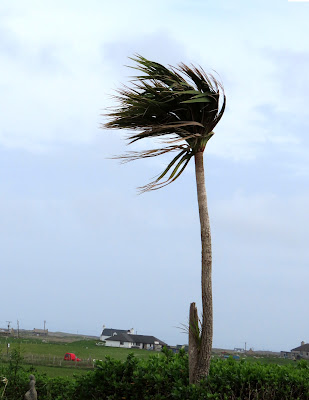Dreich, Sainsbury's and Lochindorb
Sunday April 24
Dreich is a good Scottish word meaning damp, drizzly, misty, grey, weather. That's what we got up to find this morning. Our view had disappeared. A Scotsman actually used the word to us when we met him later in the day. We needed to shop, and find that the coast is often drier, so we drove to Nairn were we knew that there was a large Sainsbury's. Along the route, we passed the northern entry to the Lochindorb road across which there was a sign, 'Road Closed'. Bother.
Before shopping, we visited Nairn Harbour where many gulls wash in the fresh water of the river mouth. Nothing unusual to-day, very little variety too. A statue, which I find fascinating, stands overlooking the harbour, as though watching over it.
The Nairn Fishwife Statue is based on an actual fishwife, Annie Ralph, who was one of the last Nairn fishwives. She represents the fishwives of Nairn and elsewhere who worked hard in their homes, raising children and supporting their fisherman husbands and brothers – gathering bait, cleaning fish and preserving them in salt water barrels or by smoking.
Most houses in Fishertown had sheds for smoking Haddock over fires of durkins (fir cones) for up to two hours. Children often collected the cones in Granny Barbour’s Wood and sold them to the Fishwives for up to ninepence a bag. Once smoked, the Haddock were packed into creels and the Fishwives would be seen selling fish throughout the town, surrounding villages and Inverness itself, carrying the fish in the wicker baskets.
After shopping, we took the coast road towards Inverness, turning inland again too visit Loch Flemington. This is a small loch flanked by a lane leading to some rather nice houses. Little Grebe, Tufted Ducks, Grey Heron, Coot and Moorhen on the loch, Of more interest were the Swallows and Sand Martins hawking for insects above it.
Alturlie Point lies on the shore of the Moray Firth, east of Inverness, with a splendid view of the Kessock Bridge, We should be accustomed to low tides, to-day's was very low indeed. Even the Corvids had deserted the shores for the ploughed fields inland. Most of the Hooded Crows here are grotty hybrids, this one had a splendid shawl but refused to show his face.
Eventually we found a lone Curlew and three Common Scoters before turning to look at the plough. Much more interesting. A group of Yellowhammers and Linnets fed on who knows what.
We decided to tackle Lochindorb from the southern end, returning via Inverness and Carrbridge. Along the road north from Carrbridge there is a grassy mound, set well back from the road. where we have seen Black Grouse in the past. Driving at a circumspect pace, we eventually found what we though was the correct site. A lot of roadside vegetation has grown up in the last three years, post Covid. Using my scope, the darker blobs in the long grass became five Black Grouse. Ever optimistic, I photographed them.
 |
Yes, the road to Lochindorb had a 'Road Closed' sign at the southern end too. We decided to carry on until we could go no further. Our first Red Grouse made an appearance, peering warily over a large tussock of grass.
A bigger surprise was our first Wheatear, a lovely male. The first time in many years that we didn't see one in Norfolk in March. Our usual favourite two lay-bys for scanning the loch. already had several vehicles parked. We took an earlier one, Within a few minutes, two Black-throated Divers appeared form the reeds at the end nearest us. They then made their way past us, up the loch, occasionally diving. We had the closest ( as close as they get here) and lengthiest views. Jammy.
The road WAS closed at the far end of the loch. We had to turn around and reverse our journey home.
Moths
Last night's moth trap produced 30 moths of 3 species. 23 of them Hebrew Character, 4 Red Chestnuts and 3 Common Quaker. We hope for something a little better to-night.. I'm not hopeful. as it's become rather cold.









Comments
Post a Comment